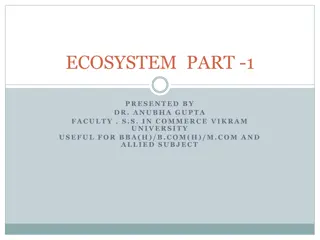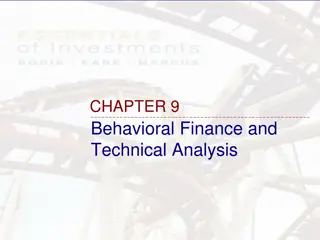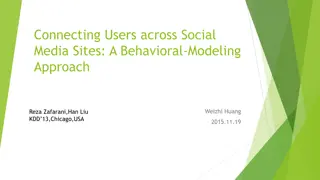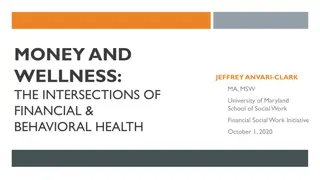
Exploring Behavioral Strategies of Financial Services Consumers in Cyberbullying Contexts
Delve into the behavioral strategies employed by financial services consumers in the face of cyberbullying. Understand the impact of digital technologies on consumer psychotypes and how cybercriminals influence them. Discover the classifications of psychotypes among digital consumers and the corresponding strategies used to manipulate them.
Download Presentation

Please find below an Image/Link to download the presentation.
The content on the website is provided AS IS for your information and personal use only. It may not be sold, licensed, or shared on other websites without obtaining consent from the author. If you encounter any issues during the download, it is possible that the publisher has removed the file from their server.
You are allowed to download the files provided on this website for personal or commercial use, subject to the condition that they are used lawfully. All files are the property of their respective owners.
The content on the website is provided AS IS for your information and personal use only. It may not be sold, licensed, or shared on other websites without obtaining consent from the author.
E N D
Presentation Transcript
BEHAVIORAL STRATEGIES OF FINANCIAL SERVICES CONSUMERS IN THE CONTEXTS OF CYBERBULLING Medyanik Olga, Medyanik Staniislav 07.06.23
TABLE OF CONTENT 01 INTRODUCTION 02 METHODS 03 RESULTS 04 CONCLUSIONS
INTRODUCTION DIGITAL TECHNOLOGIES CYBER FRAUDSTERS EMPLOY VARIOUS STRATEGIES PSYCHOTYPES OF DIGITAL CONSUMERS IDENTIFIED DIGITAL ECOSYSTEM PERSONAL INFORMATION EXPLOITATION
INTRODUCTION cybercrimes in Russia 1,195 350,000 300,000 250,000 In 2021-2022 200,000 150,000 4 basic psychotypes of digital consumers 100,000 50,000 0 2,014 2,015 2,017 2,018 2,019 2,020 2,021 2,022
METHODS The main objective was to develop a classification of psychotypes among consumers of digital goods and services and identify corresponding strategies used by cybercriminals to influence them. STAGE 2 Description of the characteristics of psychological strategies employed by digital fraudsters. 334 respondents, consisting of 250 women and 84 men STAGE 4 Make a big impact with professional slides, charts, infographics and more. STAGE 1 Identification of psychological strategies used to influence potential victims of cybercriminals 39 3rd-year students from Faculty of Psychology 13 psychological impact codes used by STAGE 3 Analysis of the basic psychotypes of digital consumers and examination of their emotional, psychological, and physiological reactions in situations of financial uncertainty and risk 822 respondents participated, with 51.2% being men and 48.8% women
RESULTS The rational psychotype of a consumer of digital goods and services is characterized by distrust of feelings, intuition, and instinctive responses when making important decisions, as well as a reluctance to rely on intuition. Psychotype Impact Code Rational Absence of impact codes The anxious psychotype of the consumer of digital goods and services exhibits difficulties with concentration, internal stiffness, insomnia, dizziness, irritability, muscle stiffness, heavy breathing, prolonged focus on problems, anxiety, inability to relax, and lack of confidence in the future. Anxious Friend Distrustful Authority, Reciprocity The distrustful psychotype of the consumer of digital goods and services is characterized by economical financial behavior, avoidance of extremes, and a general distrust of risky projects and loans. Instruction, Obligations, Fear, Profiling, Comparison, Expert Trusting The gullible psychotype of the consumer of digital goods and services is marked by uncertainty in the financial future, trust based on inner intuition, lack of financial security, and reliance on first impressions. Tab.1 Classification of basic psychotypes of digital consumers and strategies for influencing them
RESULTS Meaningful Components of Influencing Strategies Meaningful Components of Influencing Strategies Influence Code Influence Code Trust in authoritative and respected individuals with expertise Trust in those who create a sense of urgency and the illusion of necessity Authority Phantom Fixation Trust in promises and guarantees made by the scammer Profiling | Trust in those who analyze consumer profiles and exploit vulnerabilities Commitment Profiling Comparing products and services to choose the best option Trust in those who offer something for free or in exchange for something else Comparison Reciprocity Trust in those who show empathy and understanding towards problems and needs Scarcity | Trust in those who create a sense of limited availability Sympathy Scarcity Trust in those who create a threatening atmosphere and use fear tactics Trust in those who offer group membership and a sense of belonging Fear and Intimidation Social Affiliation Trust in those who create a friendly atmosphere and show interest in the consumer Trust in those who persuade with their knowledge and offer advice Friend Expertise Trust in those who provide clear instructions and guidance Instruction Tab.2 Basic strategies for the psychological impact of digital scammers
RESULTS Rational Distrustful Trusting Anxious Dia.1 Profile of psychotypes of Russian digital consumers (N=822)
CONCLUSION The gullible psychotype of consumers is at the highest risk of falling victim to cybercriminals, as they are exposed to multiple tactics of influence, including instruction, obligations, fear, profiling, comparison, and expertise. A three-stage socio-psychological study identified four basic psychotypes of consumers of digital goods and services: rational, anxious, distrustful, and trusting. Individual methods of protection against cyberbullying should be developed based on income levels and financial anxiety, offering affordable and simple protection methods for low-income individuals and more complex ones for high-income individuals. Specific preventive measures were developed for rational-trusting and trusting-anxious dominant psychotypes, such as purchasing from trusted sellers, using secure payment methods, and regularly updating software and operating systems.
RESEARCH ON THE PSYCHOLOGICAL IMPACT OF CYBERCRIMINALS ON DIGITAL CONSUMERS Typological approach Personal finance management Digital consumers Strategies such as social engineering, phishing, technology fraud, and emotional impact are employed by cyberbullies to manipulate and persuade their victims. Researchers from Ural State University of Economics formed 11 typological portraits of financial behavior based on models and stable qualities of individuals. The study resulted in a model that predicts behavioral trends and regulates credit burdens in unstable macroeconomic conditions. Destructive financial attitudes Digital skills, financial literacy, and attitudes are shaped during active digital socialization and affect financial behavior. The study identified 11 factors influencing Russian financial behavior, including financial anxiety, optimism, perception of risks, FinTech use, and investment behavior. Emotional impact Four types of financial behavior were formed: high-risk, medium- risk, low-risk, and rational psychotype.
DEMOGRAPHIC SITUATIONAL ANALYSIS OF DIGITAL PROFILES Situational factors, such as negative life events, can increase vulnerability to cybercriminals. Demographic analysis involves variables such as age, gender, income/financial status, education, and marital status. Older people are more likely to become victims of fraud. (Jorna, 2016) (Cialdini, Rhoads, 2001) PSYCHOGRAPHIC SOCIO-ECONOMIC Make a big impact with our professional slides. Different types of fraud may have specific victim profiles, such as financially literate men being targeted for investment fraud, or women with low financial literacy being victims of online shopping scams. The social portrait of deceived users includes characteristics like financial and digital literacy, negative life events, difficult financial situations, demographic factors, psychological traits, and behavioral characteristics. Somebody Age: 25 Male (Pak, Shadel, 2006) (Holtfreter, Reisig, Blomberg, 2006)






















